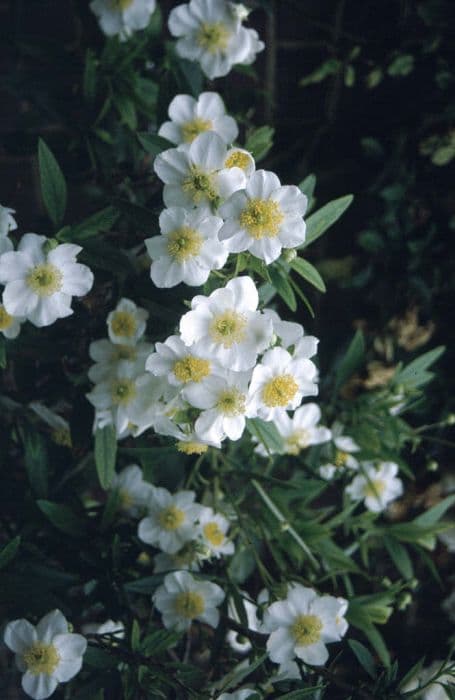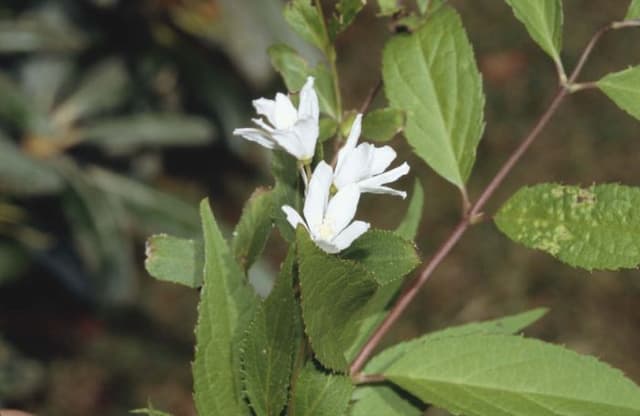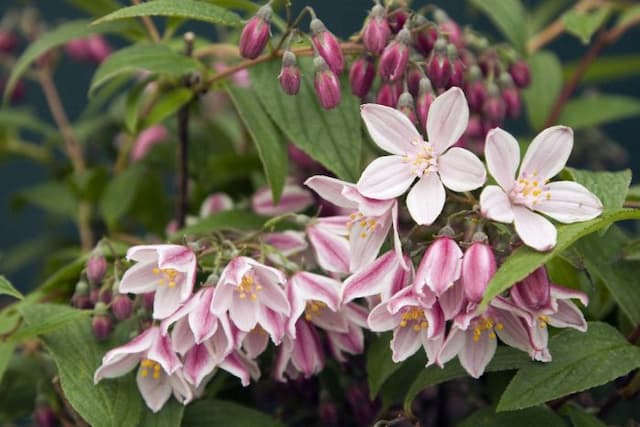Mock Orange Philadelphus 'Belle Étoile'

ABOUT
The Philadelphus 'Belle Étoile', commonly known as the 'Belle Etoile' mock orange, is a striking deciduous shrub that is highly prized for its ornamental attributes. The plant boasts a graceful arching habit with multiple stems that emanate from the base, creating an attractive fountain-like form. Its foliage is comprised of oval-shaped leaves that are medium to dark green in color, creating a lush backdrop for the flowers. The most captivating feature of the mock orange is its abundant, fragrant flowers. These blossoms are borne singly or in clusters, usually at the end of the branches. Each flower has a charming, slightly ruffled appearance with four white petals that are accentuated by a central crown of contrasting maroon or purple at the base, lending a unique, eye-catching look. Moreover, these radiant white flowers are known for their delightful fragrance, which is reminiscent of orange blossoms and can fill the air with a sweet, pervasive perfume, particularly in the late spring to early summer when the plant typically blooms. While in bloom, the 'Belle Étoile' mock orange serves as a magnet for pollinators, including bees and butterflies, who are attracted to the fragrant flowers. Outside of the flowering season, its lush foliage still maintains a strong presence in the garden, providing a steady green tableau that can contrast nicely with other garden plants. The branches may also add winter interest to the landscape with their structure and form once the leaves have fallen. The mock orange is esteemed not only for its ornamental beauty but also for being quite hardy and adaptable to a variety of garden situations. It fits well in mixed borders, as a standalone specimen or even as part of a hedging scheme, where its scent and visual appeal can be enjoyed. Overall, the Philadelphus 'Belle Étoile' mock orange is a delightful addition to the garden that provides season-long interest and an exceptional floral display without demanding excessive care.
About this plant
 Names
NamesFamily
Hydrangeaceae
Synonyms
Mock Orange, Sweet Mock Orange, English Dogwood
Common names
Philadelphus 'Belle Étoile'.
 Toxicity
ToxicityTo humans
Mock orange, specifically Philadelphus 'Belle Étoile', is not known to be toxic to humans. There is no widely recognized information suggesting that the ingestion or handling of mock orange poses a risk of poisoning or generates any harmful symptoms to humans.
To pets
Mock orange, specifically Philadelphus 'Belle Étoile', is not considered toxic to pets such as dogs and cats. It is not associated with causing poisoning symptoms if ingested and should not pose a significant risk to their health. However, as with any non-food plant material, ingestion of large quantities may cause mild gastrointestinal upset due to physical irritation rather than toxicity.
 Characteristics
CharacteristicsLife cycle
Perennials
Foliage type
Deciduous
Color of leaves
Green
Flower color
White
Height
4-5 feet (1.2-1.5 meters)
Spread
4-5 feet (1.2-1.5 meters)
Plant type
Shrub
Hardiness zones
5-8
Native area
Hybrid
Benefits
 General Benefits
General Benefits- Attractive Flowers: Produces profuse, fragrant, white blossoms that resemble single roses, adding visual appeal to the garden.
- Wildlife Attraction: The blooms attract bees, butterflies, and other pollinating insects, enhancing biodiversity.
- Low Maintenance: Requires minimal care once established, making it suitable for less attentive gardeners.
- Drought Tolerance: Once established, it has good tolerance for dry conditions, reducing the need for frequent watering.
- Adaptability: Can grow in a range of soil types, from well-drained to clay soils, making it versatile for various garden settings.
- Deciduous Nature: Sheds leaves in fall, allowing sunlight to reach ground level plants and providing seasonal interest through leaf color changes.
- Hardiness: Resilient to many diseases and pests, ensuring a healthy and long-lasting presence in the garden.
- Privacy Screen: Can be used as an informal hedge or privacy screen due to its dense growth habit.
- Fragrant Screen: Provides a pleasant scent when in bloom, which can act as a natural air-freshener for outdoor spaces.
- Seasonal Interest: Offers multi-season interest with its spring flowers, summer greenery, and fall foliage color change.
 Medical Properties
Medical PropertiesThis plant is not used for medical purposes.
 Air-purifying Qualities
Air-purifying QualitiesThis plant is not specifically known for air purifying qualities.
 Other Uses
Other Uses- Mock orange branches can be used as natural hangers or hooks after being shaped and dried, providing a rustic aesthetic for hanging clothes or jewelry.
- The strong, woody stems of mock orange can serve as garden stakes, supporting other plants that require assistance to remain upright.
- The flowers' sweet fragrance can be captured in homemade potpourri, providing a natural way to freshen up the home.
- Mock orange's dense foliage can be trimmed into topiary shapes, offering an artistic element to garden landscapes.
- Dried mock orange blooms can be included in sachets to scent drawers and closets, imparting a pleasant aroma to linens and clothing.
- Artists can use the intricate patterns of mock orange's bark and branch structure as inspiration or the subject for sketches and paintings.
- The vibrant blooms can be used as a natural dye for fabrics, yielding soft, plant-based color hues.
- Mock orange petals can be used for decorative cake toppings or frozen in ice cubes for an elegant touch in summer beverages.
- The plant's dense growth makes it suitable as a natural screen, providing privacy and blocking unsightly views.
- Photographers may utilize mock orange in its peak bloom as a beautiful backdrop for portrait photography.
Interesting Facts
 Feng Shui
Feng ShuiThe Mock Orange is not used in Feng Shui practice.
 Zodiac Sign Compitability
Zodiac Sign CompitabilityThe Mock Orange is not used in astrology practice.
 Plant Symbolism
Plant Symbolism- Innocence: Often referred to as "mock orange," Philadelphus 'Belle Étoile' has white, fragrant flowers reminiscent of pure white orange blossoms traditionally symbolizing innocence and purity.
- Eternal Love: The mock orange's resemblance to orange blossoms, which are often associated with weddings, can also imply eternal love, making it a plant that symbolizes deep commitment and enduring affection.
- Peace: The soothing fragrance and serene appearance of the mock orange flowers can be symbolic of peace and tranquility, offering a sense of calm in any setting.
- Good Luck: In some cultures, mock orange plants are believed to bring good luck to the home and its inhabitants, acting as a talisman for positive energy and fortune.
- Renaissance: The plant's capacity for vigorous growth and renewal echoes the themes of rebirth and rejuvenation, making mock oranges symbols of new beginnings and fresh starts.
 Water
WaterThe Mock Orange should be watered regularly, especially during its first growing season to establish a deep, extensive root system. Once established, they are moderately drought tolerant and typically require less frequent watering. They should be watered deeply, with about 1-2 gallons of water per week during the growing season, depending on weather conditions. Ensure that the soil is well-drained and avoid waterlogging to prevent root rot. During the winter months, reduce watering but do not allow the soil to become completely dry.
 Light
LightThe Mock Orange thrives best in full sun to partial shade. It prefers a spot that receives at least 4 to 6 hours of direct sunlight daily, with some afternoon shade in hotter climates. Good lighting is essential for the plant to produce its fragrant white flowers, but too much direct, intense sun may stress the plant, especially in the southernmost areas of its hardiness range.
 Temperature
TemperatureMock Orange plants are hardy and can tolerate a wide range of temperatures; they grow well in USDA hardiness zones 4 through 8. They can generally withstand minimum winter temperatures down to -30°F and are most comfortable during the growing season with temperatures ranging between 60°F and 85°F. Extreme heat or cold can impact the plant's health and blooming capability.
 Pruning
PruningThe Mock Orange benefits from pruning to maintain its shape, remove dead or crossed branches, and encourage vigorous growth. The best time to prune is immediately after flowering, as the plant blooms on the previous year's wood. Prune every year or every other year, depending on the plant's growth and desired size, to ensure plenty of blooms for the following season.
 Cleaning
CleaningAs needed
 Soil
SoilThe Mock Orange 'Belle Étoile' prefers well-draining soil enriched with organic matter, like compost or well-rotted manure. A slightly acidic to neutral pH ranging from 6.0 to 7.0 is ideal for optimal growth and flowering.
 Repotting
RepottingMock Orange 'Belle Étoile' is typically grown in the ground rather than pots and does not require frequent repotting. If grown in containers, repotting every 2-3 years is sufficient.
 Humidity & Misting
Humidity & MistingMock Orange 'Belle Étoile' is tolerant of a wide range of humidity levels and does well in average garden conditions without the need for specific humidity adjustments.
 Suitable locations
Suitable locationsIndoor
Grow Mock Orange 'Belle Étoile' in a bright spot and keep it pruned.
Outdoor
Plant in sun or part shade; water regularly until established.
Hardiness zone
Mock Orange 'Belle Étoile' thrives in USDA zones 5-8.
 Life cycle
Life cycleThe life cycle of the Philadelphus 'Belle Étoile', commonly known as Mock Orange, begins with seed germination, typically in the spring under suitable moisture and temperature conditions. After germination, the seedling stage sees the establishment of roots and the sprouting of initial leaves. It progresses to the vegetative stage, with the development of a sturdy stem and multiple branches, accompanied by foliage growth. Once mature, Mock Orange enters the flowering stage, usually in late spring to early summer, producing fragrant, white flowers with a maroon center, attracting pollinators. After pollination, seeds develop within the fruits, and once ripe, they are dispersed, completing the cycle. The plant can also be propagated through cuttings or layering, bypassing the seed stage, and has a perennial habit, living for many years with proper care.
 Propogation
PropogationPropogation time
Spring to Early Summer
Propogation: The most popular method of propagating the Mock Orange 'Belle Étoile' is through softwood cuttings, which are best taken in late spring or early summer. To propagate, select healthy, non-flowering stems and cut a 4 to 6 inch portion just below a leaf node. The lower leaves are then removed and the cut end may be dipped in rooting hormone to encourage root development. The cutting should then be placed in a well-draining soil mix, ensuring at least one node is below the surface. The environment should be kept humid by covering the pot with a plastic bag or using a propagator, and placed in indirect light. Roots typically form within a few weeks, after which the new Mock Orange can eventually be transplanted outdoors.







![Hydrangea [Strong Annabelle]](/_next/image?url=https%3A%2F%2Fplants-admin.emdemapps.com%2Fimages%2Fplants%2F%2Fimages%2F604b54db37d34.png&w=640&q=75)

